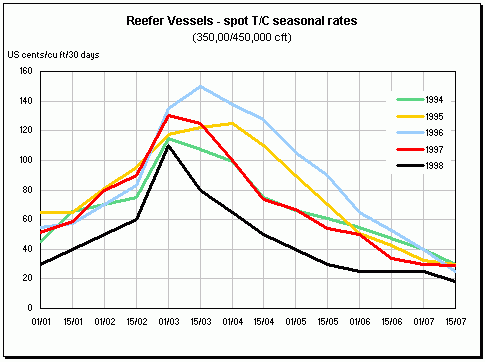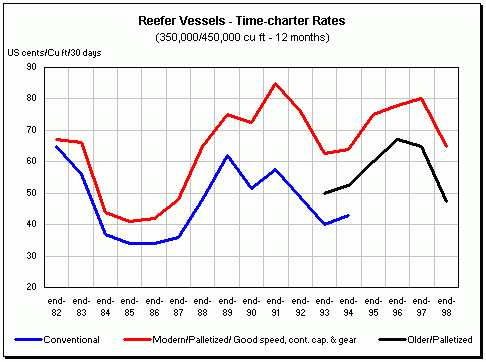
The Reefer Ship Market in 1998
At the cross-roads
Market context and trends
The 1997-1998 season was the worst that had been
experienced for 15 years. Given the climate conditions and above all an economic context
that was again diffi-cult, it was more than disappointing overall, dashing the few hopes
that the owners-operators might have had.
In the event, all the contracts were renewed at
rates below those of the previous year, and the spot rates were set on average 34% below
those obtained one year before. Furthermore, the season was extremely short, and the
seasonal rates slumped from the second half of March.
The 12-month time-charter activity was very
limited and rates were low. Large ships were once again preferred to medium-size
vessels.
Despite a slight increase in the scrapping rate,
retirements from the fleet were not able to offset the arrival of new ships.
The nature of the 1997-1998 campaign was
influenced by several factors.
Climatic events severely disrupted export
prospects in some regions of the world:
- all through the season: influence of the El Ni'o weather
pattern, with higher than normal temperatures in the northern hemisphere, abundant
rainfall in South America, drought in Central America, Indonesia, Australia and New
Zealand;
- in Ecuador 20% of the plantations were affected by
torrential rain, with one fifth of this percentage entirely destroyed;
- late apple harvest in Chile;
- in contrast to forecasts of a 20% increase in citrus
fruit exports from Morocco, rain caused a reduction of approximately 15% compared to the
previous season;
- poor core fruit harvests in New Zealand (about 25% lower
than the previous year) because of the drought;
- orange harvests in Brazil about 30% lower than the
previous year, following the development of an insect disease on the citrus fruits. To a
world economic context that w as hardly euphoric (financial crisis in the Far East and
political and economic crisis in Russia) and the unfavorable climatic effects discussed
above can be added other factors which have contributed to the negative trend in freight
rates compared to the previous year:
- increasingly strong competition from container
ships,
- increase in the world reefer ship fleet,
- strong dollar,
- high stocks of squid in Japan and Korea,
- high stocks of apples and pears in the United
States,
linked to the reduction in exports to the Far
East, leading to a decrease in imports from Chile.
The following significant events could be noted in
the market in 1998:
- January 1998: Purchase by Del Monte (which already held
51% of the shares) of the remaining 49% of Horn-Linie shares, held by the Compagnie
G'n'rale Maritime.
- January 1998: Following the condemnation of the European
Union (EU) banana import system by the World Trade Organization (WTO) in an initial
judgement in April, then on appeal in November 1997, the European Commission in Brussels
adopts a new project for submission to the EU agriculture ministers and the WTO. The main
change is the elimination of the import license system.
- March 1998: Cool Carriers starts a new weekly service
from Durban to North Europe and the United Kingdom.
- April 1998: Seatrade launches a regular service (reefer -
conventional - containers) between Europe and Argentina (Rotterdam/Sheerness,
Rosario/Buenos Aires), offering a sailing every two weeks in each direction. Three ships
of the "Hope Bay" class, 531,764 cu ft, built in 1996/1998, height 2.20 meters,
5,939 square meters, 4,250 pallets, 20 knots, 146 teu are used.
- April 1998: Swan Reefer (Actinor and Swan Shipping) buys
Irgens Larsen Holding (Agdesidens Rederi) for a reported price of US$164.5 million.
- June 1998: Seatrade launches a return service from
Antwerp to Durban, Port Elizabeth and Cape Town. The initial frequency is every 15 days,
planned to increase in the future to weekly.
- June 1998 (26): Adoption by the EU agriculture ministers
of the new banana import system, scheduled to come into force on 1 January 1999.
- July 1998: The United States files a complaint with the
WTO against this new system, judging inadequate the changes made to the previous
system.
- October 1998: Ugland takes a 10.4% holding in Swan
Reefer.
- October 1998: Outspan and Unifruco (South Africa) decide
to merge all their activities with effect from 1 January 1999, the new entity to be called
Capespan Group Holdings (the "export" branches of the two companies had already
been brought together in 1994 under the Capespan banner).
- November and December 1998: The United States threatens
unilaterally (without reference to the WTO) to take economic sanctions (imposition of
prohibitive cus toms duties on certain products) against the EU if the banana import
system is not modified (wider opening to dollar-zone bananas) by the EU before the end of
January 1999. The Europeans announce their intention to appeal to the WTO in the event
that the United States persists in its intention to impose these sanctions.
- November 1998: Unicool sets up Arctic Reefers, a new pool
that will operate ships of more than 350,000 cu ft. The initial participants are Cool
Carriers, Ahrenkiel, Eastwind, Mediteranska Plovidba, Dawn, Tokumaru, Zodiac, and
'sterreichischer Lloyd. For medium-size ships (250,000-350,000 cu ft), the Eco Shipping
pool (Cool Carriers and Eastwind) expands by 8 additional ships made available to the pool
by Eastwind.
- December 1998: Lauritzen Pacific Line reinforces its
service from South America to the West coast of the United States and from the Far East by
establishing a regular year-round weekly line between Chile, Peru, Colombia, Mexico, the
West coast of the United States on one hand, and the Far East on the other. The Far East
run will be operated by the Orient Overseas Container Line, with which Lauritzen Reefers
started cooperating in 1997.
- December 1998: The Fyffes group acquires 50% of
Capespan International Holdings (European distribution branch for Cape and Outspan brand
products) and 10% of Capespan Group Holdings.
|
| Contracts The contracts of the Canary Islands vegetable exporters, traditionally
renewed in mid-July, were concluded at the beginning of July 1997 at trip rates once again
4 to 12% lower than those of the previous year, depending on destination, on the same
basis of 12 ships.
The New Zealanders Enza and Zespri chartered their
ships in partnership and obtained terms about 5% lower than those of the previous
year.
The South African fruit exporters also obtained a
reduction of about 3% compared to the year before.
This was also the case for the Chilean fruit
exporters.
The spot market
Compared to 1997, the average level of rates on
the spot market in 1998 was disastrous for the owners-operators, with an average reduction
of about 34%.
The beginning of the high season was marked by
high availability of ships, caused mainly by below-forecast exports from Ecuador and
Chile. The traditional peak at the beginning of March, due to seasonal export volumes from
Chile, was of low amplitude, and the rates rapidly fell again because of the absence of
non-contract demand ex-South Africa and ex-New Zealand. Then from April the full influence
of El Nino was felt, in particular in Ecuador and New Zealand.
Rates thus rose only briefly at the beginning of
March, and from the beginning of June moved down to the exceptionally low bottom levels of
the period.
The spot rates obtained during the period,
starting from only 30 cents at the beginning of January (50 cents in 1997), rose a little
to 40 cents in mid-January. At the beginning of February the rates for modern ships of
350,000-450,000 cu ft were about 50 cents/cu ft/30 days (80 cents in 1997), and only 60
cents in mid-February (90 cents in 1997). A steep but short rise then occurred, taking
rates to the season's peak (beginning of March) at $1.10, 15.5% below the $1.30 obtained
at the same time of year in 1997. But they then dropped very rapidly, to 80 cents by
mid-March ($1.25 in 1997), and 65 cents at the beginning of April, reaching 50 cents in
mid-April, and continued to fall rapidly to 25 cents at the beginning of June. There was
then a degree of stability, and it might have been thought that this rate would be the
floor rate for the summer months. This was not the case, and rates of 18 cents were
reported in mid-July and even 14 cents in September (28 cents in 1997).
Like last year, most of the modern ships that were
able to find work during the summer period, even on derisory terms, obtained cargoes of
garlic ex-China and cars ex-Japan.
In the case of old ships, at least those that had
been reactivated, the traditional seasonal laying-up was obviously started very
early.

Time charters
The charter market weakened to a lesser extent,
but nevertheless significantly. The per cent decrease can be estimated at about 20%.
For the 400,000-550,000 cu ft size, the
continuation of a two-level market can again be observed, the gap between the two levels
widening a little further each year. For 12-month periods, fast modern palletized ships
with good container capacity and well geared were negotiated at rates of around 65
cents/cu ft/30 days (80 cents in 1997), whereas for first-generation palletized ships and
converted conventional ships the rates were only around 50 cents.
For the 260,000-300,000 cu ft size, the average
12- month rates were about 60 cents/cu ft/30 days, a level about 20% below that of the
previous year. The rates this year were again generally higher for large ships than for
small ones.

|
Shipping and Shipbuilding Markets 1999
I N D E X
|